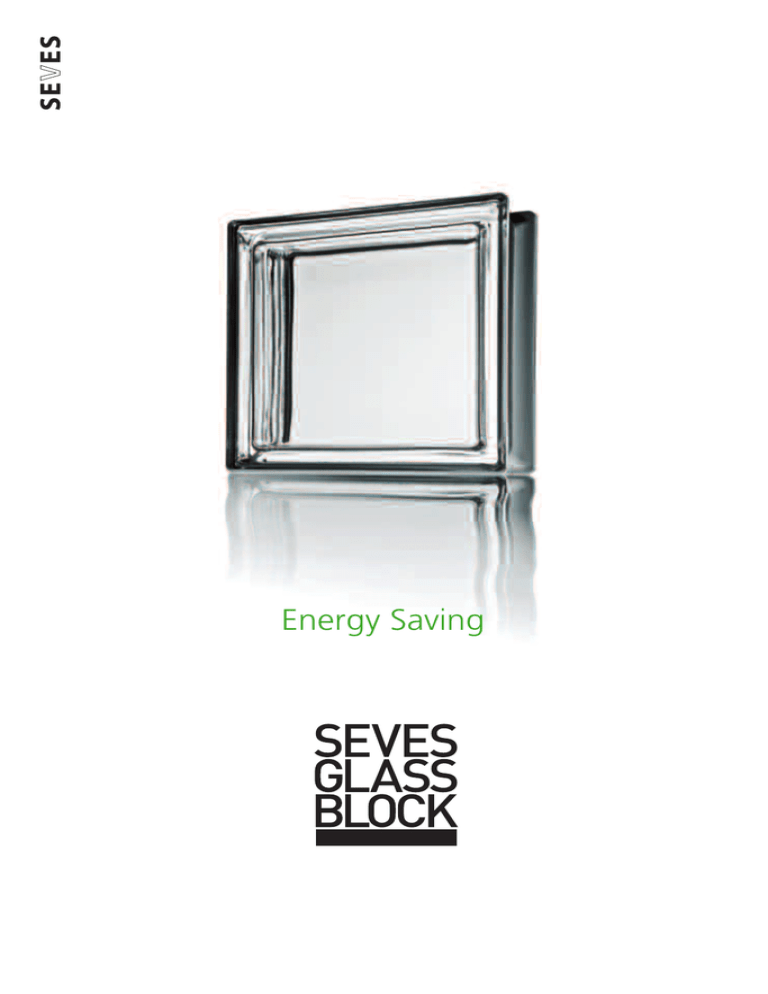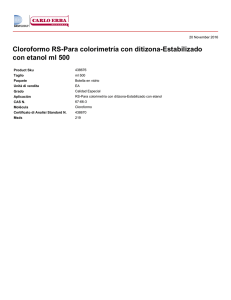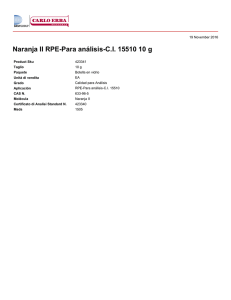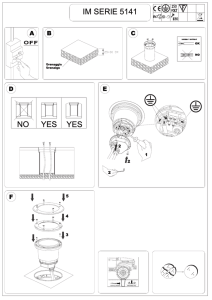Energy Saving - Seves glassblock
Anuncio

Energy Saving Progetta un futuro migliore Design a better future Projet pour un avenir meilleur Proyecta un futuro mejor Gestalten Sie eine bessere Zukunft www.sevesglassblock.com 2 Energy saving l’evoluzione del vetrocemento / the evolution of glass blocks / l’évolution de la brique de verre / la evolución del ladrillo de vidrio / die Entwicklung des Glasbausteins Seves glassblock presenta l’innovativa tecnologia “energy saving” che dimezza la trasmittanza termica del mattone di vetro classico. Questa innovativa tecnologia “energy saving” permette al mattone di vetro di raggiungere un valore di trasmissione termica pari a 1,5 W/m2K. Con questa importante novità è possibile progettare edifici interamente realizzati con il mattone di vetro. Seves glassblock presents the innovative “energy saving” technology that halves the thermal transmittance of the classic glass block. This innovative “energy saving” technology allows the glass block to reach a thermal transmission value of 1.5 W/m2k. This important new development makes it possible to design buildings made completely of glass blocks. Seves glassblock présente la technologie exclusive “energy saving” qui permet de réduire de moitié la transmission thermique de la brique de verre classique. Cette nouvelle technologie “energy saving” permet à la brique de verre d’atteindre une valeur de transmission thermique correspondant à 1,5 W/m2k. Cette importante nouveauté permet de concevoir des édifices entièrement réalisés avec la brique de verre. Seves glassblock presenta la innovadora tecnología “energy saving” que reduce a la mitad la transmitancia térmica del ladrillo de vidrio clásico. Esta innovadora tecnología “energy saving” permite al ladrillo de vidrio alcanzar un valor de transmisión térmica de 1,5 W/m2k. Con esta importante novedad pueden proyectarse edificios realizados por entero con ladrillo de vidrio. Seves glassblock präsentiert die innovative „Energy Saving“ Technologie, welche den Wärmeverlust des klassischen Glasbausteins halbiert. Diese innovative „energy saving“ Technologie ermöglicht es, dass der Glasbaustein einen Wärmedurchgangskoeffizient von 1,5 W/m2k erreicht. Mit dieser neuen Entwicklung lassen sich Gebäude vollständig aus Glasbausteinen realisieren. Torre Malecon Buenos Aires - Argentina The AIA Committee on the environment named Edificio Malecom as one of the “Top 10 green project” 4 Il risparmio energetico Energy saving / Les economies d’energie / El ahorro energético / Energie Sparen Nuovi mattoni di vetro ENERGY SAVING Da sempre attenta alla salvaguardia dell’ambiente e al risparmio energetico, Seves mette a segno un importante traguardo per un’architettura del vetro più sostenibile ed ecologica. Grazie alla definizione di una nuova filosofia del processo produttivo, SEVES, leader nella produzione mondiale di mattone di vetro, ha messo a punto una nuova tecnologia che migliora le prestazioni relative alla riflessione e trasmissione dell’energia solare nel vetro, senza alterarne le caratteristiche meccaniche e chimiche. La nuova tecnologia ENERGY SAVING rende così possibile che un mattone di vetro, nel formato Pegasus 19x19x8cm, raggiunga un valore di trasmittanza termica pari a 1,5 W/m2k a fronte di un valore attuale di 2,8 W/m2k. New energy saving glass blocks Always attentive to safeguarding and protecting the environment and to saving energy, Seves has achieved an important goal in glass architecture with the introduction of a more sustainable and eco-friendly solution. The definition of a new philosophy in the production process has allowed SEVES, a world leader in the manufacturing of glass blocks, to perfect a new technology that improves the performances relating to the reflection and transmission of solar energy in the glass block, without altering its mechanical and chemical characteristics. As a result, the new ENERGY SAVING technology makes it possible for a glass block, e.g. the Pegasus 19x19x8cm, to reach a thermal transmittance value of 1.5 W/m2k compared to the current value of 2.8 W/m2k. Nouvelles briques de verre ENERGY SAVING Seves qui est depuis toujours attentive à la sauvegarde de l’environnement et aux économies d’énergie, a atteint un objectif important pour une architecture en verre plus soutenable et écologique. Grâce à la définition d’une nouvelle philosophie dans le processus de production, SEVES, l'entreprise leader mondiale dans la production de la brique de verre a mis au point une nouvelle technologie qui améliore les propriétés de réflexion et transmission de l’énergie solaire du verre, sans pour cela en altérer les caractéristiques mécaniques et chimiques. La nouvelle technologie ENERGY SAVING permet, ainsi, qu’une brique de verre dans le format Pegasus 19x19x8cm atteigne une valeur de transmission thermique correspondant à U=1,5 W/m2K par rapport à la valeur actuelle de 2,8 W/m2k. Nuevos ladrillos de vidrio energy saving Atenta desde siempre a la protección del medio ambiente y el ahorro energético, Seves conquista un importante objetivo para una arquitectura del vidrio más sostenible y ecológica. Gracias a la definición de una nueva filosofía del proceso productivo, SEVES, líder en la producción mundial de ladrillo de vidrio, ha puesto a punto una nueva tecnología que mejora las prestaciones en relación con la reflexión y transmisión de la energía solar en el vidrio, sin alterar las características mecánicas y químicas. La nueva tecnología ENERGY SAVING hace así posible que un ladrillo de vidrio, en el formato Pegasus 19x19x8cm, alcance un valor de transmitancia térmica de 1,5 W/m2k contra un valor actual de 2,8 W/m2k. Neue „Energy Saving“ Glasbausteine Seves ist seit je her auf Umweltschutz und Energieersparnis bedacht und hat sich ein wichtiges Ziel gesetzt: eine nachhaltigere und ökologischere Architektur des Glases. Dank eines völlig neuen Herangehens an den Produktionsprozess hat SEVES, ein weltweit führender Hersteller von Glasbausteinen, eine Technologie entwickelt, welche die physikalischen Eigenschaften für Reflexion und Transmission der Sonnenenergie im Glas verbessert, ohne dessen mechanische und chemische Eigenschaften zu beeinflussen. Die neue Technologie ENERGY SAVING ermöglicht es so, dass ein Glasbaustein im Format Pegasus 19x19x8cm einen Wärmedurchgangskoeffizient von 1,5 W/m2k erreicht, gegenüber einem aktuellen Wert von 2,8 W/m2k. Reception Centre of "Updown Court" - Taiwan Project: Mr.Gong Shu Zhang - AURA Architects & Associates, 2007 Basic Line - CLEAR 1919/8 WAVE 6 Isolamento termico Thermal insulation / Isolation thermique / Aislamiento térmico / Wärmedämmung Il mattone in vetro classico è costituito da due semigusci in cui all’interno è presente dell’aria priva di umidità. Questo sistema è equiparabile ad un sistema costituito da due lastre di vetro float accoppiate tra loro con interposta una “camera” contenente sempre aria priva di umidità. Il nuovo sistema di mattoni “Energy Saving”, brevettato da Seves, sviluppa il principio delle “camere”. Il sistema frappone, tra i due semigusci del mattone, una lastra di vetro float con caratteristiche di bassa emissività (1). Vengono così a crearsi due “camere” e lo spazio racchiuso in esse non è più costituito da aria ma da gas Argon (2). Le superfici di vetro passano quindi da due a tre e l’effetto congiunto della lastra di “ basso emissivo”, dell’Argon e delle tre superfici di vetro, riesce così ad abbattere sensibilmente il valore di trasmittanza termica (3) nel mattone (vedi valori indicati in tabella). The classic glass block is made up of two half-shells containing air without humidity. This system is comparable to a system made up of two floating glass sheets joined together with the interposition of a “chamber” containing air without humidity. The new “Energy Saving” system patented by Seves develops the principle of “chambers”. The system puts a sheet of floating glass between the two halves of the block. This sheet is characterised by low emissivity (1). In this way, two “chambers” are created and the space enclosed in them no longer contains air, but Argon gas (2). As a result, the glass surfaces increase from two to three and the combined effect of the “low emissive” glass sheet, the Argon and the three glass surfaces allows considerably reducing the block’s thermal transmittance value (3) (see values reported in the table). Isolamento termico Thermal insulation Formato (cm) Campione sottoposto a prova Coefficiente di trasmittanza termica unitaria “U” certificata Format (cm) Test sample Certified coefficient of unitary thermal transmittance (U) W/m2K W/m2K (Watt/m2 per grado Kelvin) (Watt/m2 per degree Kelvin) 19x19x8 Singolo mattone 2,8 19x19x8 Single block 2.8 19x19x8 Energy Saving Singolo mattone 1,5 19x19x8 Energy Saving Single block 1.5 (I risultati sui pannelli possono variare secondo il materiale usato per la costruzione del pannello) (The results on the panels may vary depending on the material used to build the panel) (1) (1) (2) (3) basso emissivo: vetro float con trattamento superficiale di coating metallici gas Argon: gas nobile inerte incolore con caratteristiche di isolamento termico trasmittanza termica: scambio termico che si verifica attraverso le superfici mediante conduzione, convezione, irraggiamento (2) (3) Low emissivity: floating glass with metallic coating Argon gas: colourless inert noble gas with thermal insulation properties Thermal transmittance: thermal exchange that passes through the surfaces by means of conduction, convection, irradiation La brique de verre classique se compose de deux demicoques à l’intérieur desquelles se trouve de l’air ne contenant pas d’humidité. Ce système peut être comparé à un système composé de deux plaques de verre float avec une couche (“chambre”) d’air sec entre elles. Le nouveau système de briques “Energy Saving”, breveté par Seves, développe ce principe des “chambres ”. Le système introduit entre les deux demi-coques de la brique de verre, une plaque de verre float à basse émissivité (1). On obtient ainsi deux “chambres” et l’espace contenu entre celles-ci n’est plus constitué par de l’air mais par du gaz Argon (2). Les surfaces en verre passent donc de deux à trois et l’association de la plaque à “ basse émissivité”, de l’Argon et des trois surfaces de verre, permet d’abattre sensiblement la valeur de transmission thermique (3) dans la brique de verre (voir les valeurs indiquées dans le tableau). El ladrillo de vidrio clásico está formado por dos mitades que encierran en su interior aire carente de humedad. Este sistema puede compararse con un sistema formado por dos placas de vidrio plano unidas entre sí con una “cámara” interpuesta cuyo interior contiene siempre aire carente de humedad. El nuevo sistema de ladrillos “Energy Saving”, patentado por Seves, desarrolla el principio de las “cámaras”. El sistema interpone, entre las dos mitades del ladrillo, una lámina de vidrio plano con características de baja emisividad (1). Se crean así dos “cámaras”, y el espacio encerrado entre ellas está constituido, ya no por aire, sino por gas Argón (2). Las superficies de vidrio pasan así de dos a tres, y el efecto conjunto de la placa de “baja emisión”, del Argón y de las tres superficies de vidrio, consigue así disminuir sensiblemente el valor de transmitancia térmica (3) en el ladrillo (ver valores indicados en la tabla). Isolation thermique Aislamiento térmico Format (cm) Échantillon soumis à test Coefficient de transmission thermique unitaire “U” certifiée (2) (3) Muestra sometida a prueba Coeficiente de transmitancia térmica unitaria “U” certificada W/m2K W/m2K (Watt/m2 par degré Kelvin) (Watt/m2 por grado Kelvin) 19x19x8 Brique simple 2,8 19x19x8 Ladrillo unitario 2,8 19x19x8 Energy Saving Brique simple 1,5 19x19x8 Energy Saving Ladrillo unitario 1,5 (Les résultats sur les panneaux peuvent varier selon le matériau utilisé pour la construction du panneau) (1) Formato (cm) basse émissivité : verre float avec traitement superficiel de coating métallique gaz Argon : gaz noble inerte incolore avec caractéristiques d’isolation thermique transmission thermique : échange thermique qui a lieu par l’intermédiaire des surfaces moyennant conduction, convection, rayonnement (Los resultados en los paneles pueden variar según el material usado para la construcción del panel) (1) (2) (3) de baja emisión: vidrio plano con tratamiento superficial de revestimiento metálico. gas Argón: gas noble inerte incoloro con características de aislamiento térmico. transmitancia térmica: intercambio térmico que se produce a través de las superficies mediante conducción, convección, irradiación. 7 Proprietà e funzione del vetro Glass properties and function / Propriétés et fonction du verre / Propiedades y función del vidrio / Eigenschaften und Funktion des Glases Scambi di calore attraverso una parete / Heat exchange through a wall / Échanges de chaleur à travers une paroi / Intercambios de calor a través de una pared / Wärmeaustausch durch eine Wand Scambio termico per conduzione La conduzione è un trasferimento di calore attraverso un corpo o tra due corpi a contatto diretto tra loro. Tale trasferimento si verifica senza alcuno spostamento di materia. Der klassische Glasbaustein besteht aus zwei Hälften, in denen trockene Luft im Inneren enthalten ist. Dieses System ist vergleichbar mit einem System bestehend aus zwei Scheiben Floatglas, zusammengefügt mit einer innenliegenden "Kammer", welche trockene Luft enthält. Das neue, von Seves patentierte Glassteinsystem „Energy Saving“, entwickelt das Prinzip der „Kammern“ weiter. Bei diesem neuen System wird zwischen die beiden Hälften des Glassteins eine Floatglasscheibe mit geringem Emissionsgrad (1) eingefügt. Somit werden zwei „Kammern“ geschaffen, welche zusätzlich mit Argon-Gas (2) gefüllt werden. Die Anzahl der Glasschichten steigt als von zwei auf drei und die Kombination aus Floatglas mit „geringem Emissionsgrad", Argonfüllung und der drei Glasschichten führen so zu einer erheblichen Reduktion des Wärmedurchgangskoeffizient (3) im Glasbaustein (siehe Werte in der Tabelle). Freddo Cold Froid Frío Kälte Caldo Hot Chaud Caliente Hitze Échange thermique moyennant conduction. La conduction correspond à un transfert thermique à travers un corps ou entre deux corps qui se trouvent directement en contact. Ce transfert a lieu sans aucun déplacement de matière. Intercambio térmico por conducción La conducción es una transferencia de calor a través de un cuerpo o entre dos cuerpos en contacto directo entre sí. Dicha transferencia se produce sin ningún desplazamiento de materia. Wärmeaustausch durch Wärmeleitung. Die Wärmeleitung ist die Übertragung von Wärme durch einen Körper oder zwischen zwei Körpern, die in direktem Kontakt miteinander stehen. Diese Übertragung erfolgt ohne Verschiebung von Materie. Wärmedämmung Format (cm) Untersuchte Probe Wärmedurchgangskoeffizient „U“ zertifiziert W/m2K Freddo Cold Froid Frío Kälte Caldo Hot Chaud Caliente Hitze (Watt/m2 per Grad Kelvin) 19x19x8 Einzelner Glasbaustein 2,8 19x19x8 Energy Saving Einzelner Glasbaustein 1,5 (Die Ergebnisse der Elemente können variieren, abhängig von dem für den Bau des Elementes verwendeten Materials) (1) (2) (3) Vento Wind Vent Viento Wind Scambio termico per convenzione La convenzione è un trasferimento di calore che avviene tra la superficie di un corpo solido e un fluido, liquido o gassoso. Tale trasferimento è accompagnato da uno spostamento di materia. Thermal exchange by convection. Convection is the transfer of heat that occurs between the surfaces of a solid body and a fluid, liquid or gas. This transfer is accompanied by a movement of matter. Échange thermique moyennant convection. La convection est un mode de transfert de chaleur qui a lieu entre la surface d’un corps solide et un fluide, liquide ou gazeux. Ce transfert s’accompagne d’un déplacement de matière. niedrige Emission: Floatglas mit metallischer Beschichtung Gas Argon: farblos, inertes Edelgas mit Eigenschaften der Wärmedämmung Wärmedurchgangskoeffizient: Wärmetausch über die Oberflächen durch Wärmeleitung, Konvektion, Strahlung Udine International School - Italy Project: Gianni Lerussi, 2004 Pegasus - NEUTRO Q19 O Thermal exchange by conduction. Conduction is the transfer of heat through a body or between two bodies in direct contact with each other. This transfer occurs without any movement of matter. Intercambio térmico por convección. La convección es una transferencia de calor entre la superficie de un cuerpo sólido y un fluido, líquido o gaseoso. Dicha transferencia va acompañada por un desplazamiento de materia. Wärmeaustausch durch Konvektion. Die Konvektion ist ein Wärmeübergang zwischen der Oberfläche eines festen Körpers und einer Flüssigkeit oder Gases. Diese Übertragung wird durch eine Verschiebung der Materie begleitet. Freddo Cold Froid Frío Kälte Caldo Hot Chaud Caliente Hitze Scambio termico per irraggiamento L’irraggiamento è un trasferimento di calore che avviene attraverso onde elettromagnetiche tra due corpi a temperature diverse. Thermal exchange by irradiation. Irradiation is the transfer of heat that occurs between two bodies with different temperatures by means of electromagnetic waves. Échange thermique moyennant rayonnement. Le rayonnement correspond à un transfert de chaleur qui a lieu par l’intermédiaire d’ondes électromagnétiques entre deux corps à différentes températures. Intercambio térmico por irradiación. La irradiación es una transferencia de calor mediante ondas electromagnéticas entre dos cuerpos a temperaturas distintas. Wärmeaustausch durch Strahlung. Die Strahlung ist eine Wärme-Übertragung, die über elektromagnetische Wellen zwischen zwei Körpern bei unterschiedlichen Temperaturen stattfindet. 8 Il rispetto delle normative Observance of the regulations / Le respect des normes / El respeto de las normativas / Die Einhaltung der Normen I nuovi mattoni di vetro ENERGY SAVING sono stati sottoposti ai normali test necessari per la marcatura CE secondo le norme UNI EN 1051-1 e 1051-2 e alle seguenti prove di laboratorio: - Resistenza alla compressione lungo il fianco del mattone secondo norme EN 1051/1 2005; - Resistenza allo shock termico; secondo norme EN 1051/2 2008; - valutazione delle caratteristiche solari EN 410 2000; - calcolo dell’U-Value EN 673 2005; - isolamento acustico EN 7117/1 2007. Les nouvelles briques de verre ENERGY SAVING, en plus des tests nécessaires pour le marquage CE conformément aux normes UNI EN 1051-1 et 1051-2, ont été soumises aux tests de laboratoire suivants : - Résistance à la compression sur le côté de la brique conformément aux normes EN 1051/1 : 2005 ; - Résistance au choc thermique conformément aux normes UNI EN 1051/2 2008 ; - évaluation des caractéristiques solaires conformément aux normes UNI EN 410 2000 ; - calcul de la valeur U conformément aux normes EN 673 2005; - isolement acoustique conformément aux normes EN 7117/1 2007. Los nuevos ladrillos de vidrio ENERGY SAVING han sido sometidos a los test normalmente necesarios para la marca CE según las normas UNI EN 1051-1 y 1051-2 y a las siguientes pruebas de laboratorio: - Resistencia a la compresión en el lateral del ladrillo conforme a las normas EN 1051/1 2005; - Resistencia al shock térmico; conforme a las normas EN 1051/2 2008; - evaluación de las características solares EN 410 2000; - cálculo del U-Value EN 673 2005; - aislamiento acústico EN 7117/1 2007. Die neuen Glasbausteine ENERGY SAVING wurden der notwendigen Prüfung für die CE-Kennzeichnung unterzogen, gemäß den Normen UNI EN 1051-1 und 1051-2 und den folgenden zusätzlichen Labortests: - Druckfestigkeit des Steins in Übereinstimmung mit den Normen EN 1051 /1 2005, - Widerstand gegen thermischen Schock, nach Normen EN 1051/2 2008, - Bewertung von Solarcharakteristika EN 410 2000, - Berechnung des U-Werts EN 673 2005; - Schallschutz EN 7117/1 2007. The new ENERGY SAVING glass blocks were subjected to the tests necessary for obtaining the CE mark in compliance with the UNI EN 1051-1 and 1051-2 standards, as well as the following laboratory tests: - Resistance to compression along the side of the block in accordance with the EN 1051/1 2005 standard; - Resistance to thermal shock in accordance with the EN 1051/2 2008 standard; - Evaluation of the solar characteristics, EN 410 2000; - Calculation of the U-Value, EN 673 2005; - Acoustic insulation, EN 7117/1 2007. A S S E S S O R S of the Materialprüfungs- und Versuchsanstalt Neuwied GmbH Approved testing, monitoring and certification organisation under construction supervisory law Approved monitoring organisation in accordance to DIN 1045-3 Forschungsinstitut für vulkanische Baustoffe Approved under civil law in compliance with “RAP Stra” Abstract of the results of expertise No.: 601943/09 SEVES S.p.A. Via Reginaldo Guiliani 360 Applicant: Firenze-Italy Object of application: Determination of thermal transmittance (U-value) of a Glass Block Wall Figure 1: Isothermal lines Glass Block Wall Type 1919/8 Pegasus Energy Saving Glass Block with a visible seam thickness of 2 mm λeq [W/(m*K)] U value [W/(m²*K)] U value, rounded [W/(m²*K)] 0,167 1,547 1,5 Table 1: Results Glass Block Wall Type 1919/8 Pegasus Energy Saving Glass Block Date: 11. Dezember 2009 This summary of the results is only an overview. For further use only the sealed full report no.: 600554/09 is legal. The test report shall not be reproduced in any abridged form, in extracts, or for advertising purposes unless this Institute has given its prior written consent. This test report is a translation of a German test report. In cases of doubt only the German version is relevant. G:\2009\60_1943_ku_solaris_Seves\1943gb_solaris_100_eng.doc Bank account: Sparkasse Neuwied (Bank branch code BLZ 57450120) A/c. 14027 Managing director: Dr. Karl-Uwe Voß Place of jurisdiction: Neuwied Register Court Montabaur: HRB 10074 Tutti i valori sono certificati da laboratori internazionali. Copia della certificazione relativa può essere richiesta direttamente al servizio tecnico Seves ed è disponibile sul sito www.sevesglassblock.com All the values are certified by international laboratories. A copy of the relative certification can be requested directly from the Seves technical centre and is available on the website www.sevesglassblock.com Toutes ces valeurs sont certifiées par des laboratoires internationaux. Une copie de cette certification peut être demandée directement au service technique Seves, elle est également disponible sur le site www.sevesglassblock.com. Todos los valores han sido certificados por laboratorios internacionales. Una copia de la certificación correspondiente puede solicitarse directamente al servicio técnico Seves y está a su disposición en el sitio www.sevesglassblock.com Alle Werte wurden von internationalen Labors geprüft. Eine Kopie der entsprechenden Zertifizierung kann direkt beim technischen Dienst von Seves angefragt werden und steht auf der Website www.sevesglassblock.com zur Verfügung. 9 Locarno Teleferic - Switzerland Project: Mario Botta, 2000 Pegasus - NEUTRO Q19 T SAT EGS03/10 www.sevesglassblock.com AMERICAS EUROPE Seves S.p.A. Administration, Offices, Factories, Warehouses Via R. Giuliani, 360 50141 Firenze - Italia Tel.: +39 055 449 51 Fax: +39 055 425 009 6 Sales Dept. Fax: +39 055 455 295 Vitrablok, S.r.o. Administration, Offices, Factories, Warehouses Bílinská 42 - 419 14 Duchcov Ceˇ ská Republika Tel.: +420 417 818 111 Fax: +420 417 835 807 Sales Dept. Fax: +420 417 835 535 Delegación Península Ibérica Vetro Iberia, S.L. Offices C./ Rosas 6, local 50009 Zaragoza España Tel.: +34 (976) 30 60 26 Fax: +34 (976) 55 25 58 Seves Glassblock Brasil S.A. Administration, Offices, Factories, Warehouses Av. Lúcio Thomé Feteira, 312 Parte CEP 24415-000 São Gonçalo RJ - Brasil Tel.: +55 (21) 3707 9108 Fax: +55 (21) 3707 9113 Seves reserves its right to make, at its own discretion, any changes either technical or to the colour, size and finishing of its products which it deems necessary. Seves also reserves its right to stop manufacturing.



